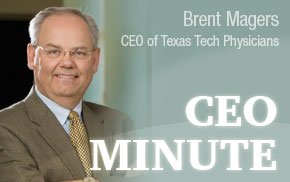 As you know, for several years Texas Tech Physicians has emphasized hand-washing.
Still do. Most institutional providers of health care emphasize hand-washing, that
is not unusual. Sadly, as an industry, our compliance with proper hand-washing is
disappointing when trained observers watch and report findings. Despite all of the
advances in medicine, experts tell us hand-washing is the most effective way to control
the spread of germs. Dr. Semmelweis was correct those many years ago. But, this article
is not about hand-washing, it is about patient contact.
As you know, for several years Texas Tech Physicians has emphasized hand-washing.
Still do. Most institutional providers of health care emphasize hand-washing, that
is not unusual. Sadly, as an industry, our compliance with proper hand-washing is
disappointing when trained observers watch and report findings. Despite all of the
advances in medicine, experts tell us hand-washing is the most effective way to control
the spread of germs. Dr. Semmelweis was correct those many years ago. But, this article
is not about hand-washing, it is about patient contact.To set this up, not long ago, a group of us were discussing putting sinks in some new exam rooms. The debate was around the need for sinks, how much patient contact occurs, and so forth. At the conclusion of the discussion, we ended up putting the sinks in the rooms. A good decision, I thought. I mention this because of a recent piece in the New York Times, which caught my eye. It was written by Danielle Ofri, M.D., Ph.D. She is a writer, editor and practicing internist in New York City. In her article, she talks about the benefits of patient contact and listening to his heart and lungs. She wrote:
“Does the physical exam serve any other purpose? The doctor-patient relationship is fundamentally different from, say, the accountant-client relationship. The laying on of hands sets medical practitioners apart from their counterparts in the business world. Despite the inroads of evidence-based medicine, MRIs, angiograms and PET scanners, there is clearly something special, perhaps even healing, about touch. There is a warmth of connection that supersedes anything intellectual, and that connection goes both ways in the doctor-patient relationship.”
